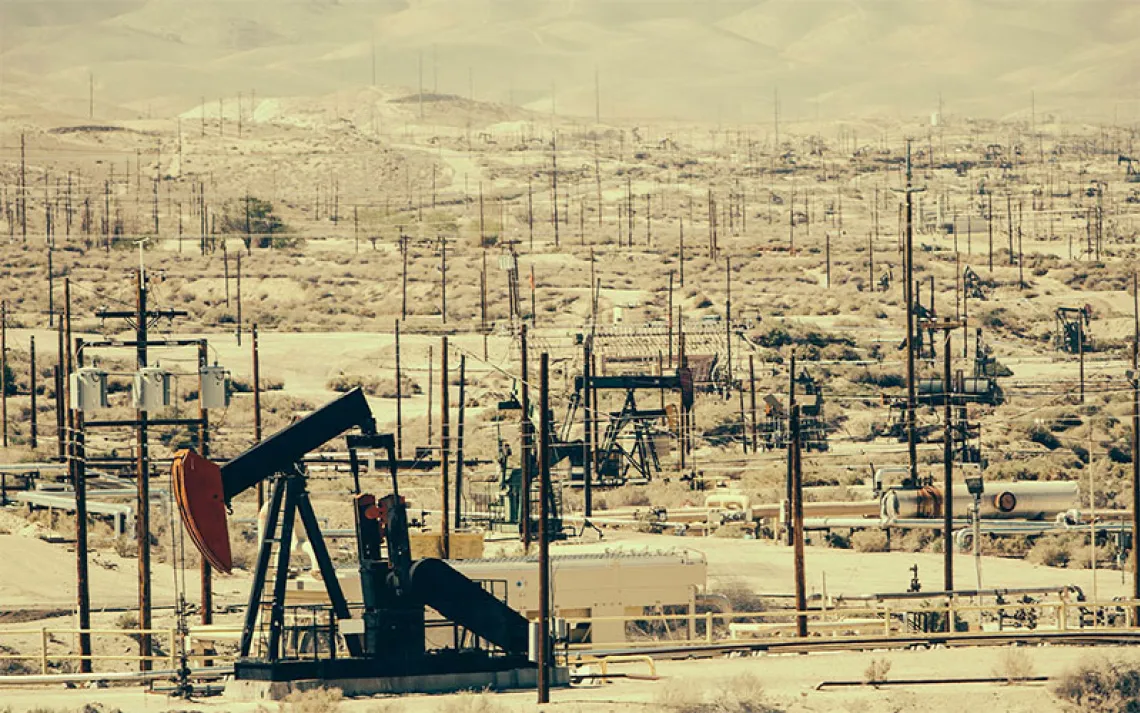Fracked Gas Pipelines Are Good for You
Are Oregonians buying Pembina's pitch for a controversial gas project?

What is this ad selling?
The evocative image is of a lakeside camp at dusk. The tagline—“Respect Oregon”—stands out against a deep cobalt sky. The tent is illuminated from within; a family, bathed in the warm light of a campfire, roasts marshmallows. The tableau is evidently crafted to reflect cherished Oregon values: natural beauty, outdoor recreation, and small-town life.
This scene is one panel of a glossy, four-page brochure that began appearing in some Oregonians’ mailboxes in the fall of 2018. Similar mailings featured a son and father fly-fishing; a pair of hunters sipping coffee on a pickup’s tailgate; and a noble-looking black Lab in profile, with a rugged mountain landscape in the background. Each of the mailings comes with messages like these:
“We are your neighbors and friends.”
“We do things differently, because this is our home. We are Pembina.”
The slick brochures do not explain that Pembina is a Canadian oil and gas firm, or provide details on its plans to build a massive gas liquefaction terminal at Coos Bay on Oregon’s south coast, or explain that the LNG plant will require the construction of a 229-mile, 36-inch-diameter gas pipeline across southwest Oregon. In fact, if you didn’t know better, “Jordan Cove LNG” might simply be the latest microbrew.


Frank Adams lives in the rural community of Tenmile, Oregon, and his property is on the proposed pipeline route; he began receiving the brochures promoting the Jordan Cove Energy Project last year. He calls the ads “propaganda.” “I just throw them straight into the trash,” Adams says.
Jordan Cove is a subsidiary of Pembina Pipeline Corporation, which is based in Calgary, Canada. In May 2017, the company acquired another oil and gas infrastructure firm, Veresen, and inherited the Jordan Cove project, which has been in the works since the early aughts. If the terminal were to be built, the gas would likely come from fracking fields in Canada and western Colorado and then be transported from Malin, Oregon, to Coos Bay via a new pipeline called the Pacific Connector. Once liquefied at the new LNG terminal, the gas would be exported to Asia. If built, Jordan Cove will export 7.8 million metric tons of LNG per year, or the equivalent of 1.3 billion cubic feet per day.

Sign up to receive Sierra News & Views
Get articles like this one sent directly to your inbox weekly.
With this action you affirm you want to receive Sierra Club communications and may vote on policy designated by the Sierra Club Board.
The project has been contentious since it was first proposed more than a decade ago as an import terminal. In March 2016, the Federal Energy Regulatory Commission denied the project’s permit, concluding that the public benefits did not outweigh the negative impacts to landowners and communities. In September 2017, Pembina filed a new application. FERC expects to make its final decision on the project by January 2020.
Pembina launched its media blitz just before the November 2018 election. (During 2017 and 2018, Jordan Cove donated nearly $200,000 to political action committees and campaigns, including $70,000 to ChamberPAC, which in turn directly supported several pro-business candidates in the 2018 elections. Jordan Cove also contributed $50,000 to the campaign of Coos County Commissioner John Sweet, an avid supporter of Jordan Cove. Sweet was re-elected with 57 percent of the vote.) A series of print ads were mailed to thousands of residents in Jackson, Coos, Douglas, and Klamath Counties. Television and radio ads appeared in those four counties as well as in other Oregon communities such as Corvallis, Eugene, and Portland. Some local residents say that pro-Jordan Cove ads have been popping up on YouTube and on smartphone game apps such as Words With Friends.
In a January interview with a regional public radio host, Jordan Cove spokesman Michael Hinrichs claimed that the effort, which he called an “education and engagement campaign,” was launched “after hearing from folks that they wanted more engagement.”
But opponents of the Jordan Cove LNG plant aren’t buying the seductive messaging. “You would think they were corporate saints, beloved by their blue-suited employees, making the safest pipeline transfers of any company in that business,” says Charlie Miller, a Corvallis resident and longtime opponent of Jordan Cove. “Just neighbors having a happy cup with the home folk down at Sally's Coffee Klatch."

In a December letter to The World newspaper in Coos Bay, one local resident, Janice Williams, wrote, “The television ads for Jordan Cove Energy Project should come with a disclaimer like those mandated for pharmaceuticals. . . . When you catch one of the TV spots or get a mailer, please notice the beauty they use as a backdrop, because a backdrop is all our precious bay and southern Oregon is to the Canadian Pembina Corporation. It’s only about profit and the means to send their polluting fossil fuel across an already stressed planet.”
Miller, Williams, and other local residents cite a litany of reasons for being opposed to the project: safety concerns; the project’s risks to the local environment and water quality; its contributions to climate change; and the possible use of eminent domain to take properties away from landowners. The eminent domain issue has struck a chord with people across the political spectrum, many of whom dislike the notion of a Canadian company using Oregon to transport gas for export to other countries.
The Jordan Cove PR campaign uses imagery, messaging, and color schemes intended to address—or dismiss—such concerns.
Text in the print and TV ads is white, teal, dark blue, or bright green—colors typically associated with healthy environments and benign enterprises. The Jordan Cove logo features a wave comprised of three colored “swooshes”: one teal, two green. In contrast, the Pembina logo—which appears nowhere on the ads or the Jordan Cove LNG website—features bold black letters underscored by red and gray stripes.
The ads depict neighborly conversations with landowners and tribal members. Several of the television ads feature an African American man, a Native American woman, and a white male Pembina employee standing in a field, presumably discussing plans for a pipeline easement. (The ethnically diverse trio also appear in the print ads and on the website.) In one TV spot, titled “Can you spot the pipeline?,” the three confer as ambient music swells in the background. The phrase “This land is your land” appears at the bottom of the screen, underscored in green, followed by another message that subtly echoes the Native American “seventh generation” ethos: “That’s why the Jordan Cove project will maintain the natural beauty of southern Oregon and the south coast for future generations.” That same ad shows land during and after pipeline construction, where a lush field of corn conceals the scar. All of the “before and after” pipeline imagery is of flat agricultural land; in fact, much of the terrain to be traversed by the Pacific Connector pipeline is mountainous and forested.
Other ads try to combat the notion of Pembina as an outsider. One print ad introduces Pembina not just as the new manager of the Jordan Cove Project but as “your neighbors and friends.” A flannel-clad patron sits at diner counter, chatting with friends, one of whom wears a Pembina ball cap, while a mixed-race couple dines at a table in the background. You can almost smell the home fries and bacon.
During his appearance on public radio at the beginning of the year, Jordan Cove spokesperson Hinrichs would not disclose exactly how much the company is spending on PR. But one thing is certain: The project is all about money, and Pembina is willing to spend millions to earn billions. The LNG terminal and pipeline represent a $10 billion investment. Pembina earmarked $135 million in 2018 and $100 million in 2019 for moving the Jordan Cove project forward. The money is going toward satisfying regulatory demands and acquiring permits, securing binding agreements (contracts) for the gas, pipeline engineering, and securing easements from landowners.
As the PR blitz continues, Jordan Cove’s land agents are quietly making deals with landowners along the pipeline route. A Klamath County resident, who asked that her name be withheld, was initially approached in 2013 with an offer of $6,900 for a 10-acre easement on her 132-acre parcel. In August 2018 Jordan Cove sent her a letter offering $95,000 for the same easement; by October 2018, the offer had spiked to $254,000. Most recently, she received a new offer of $500,000.
Deb Evans, a landowner who lives in Jackson County, claims that some landowners have been offered upwards of $1 million for their easements. A representative from the Niskanen Center, a Washington, D.C.-based, libertarian-leaning think tank that has offered to represent Oregon landowners in eminent domain cases, described these offers as “unprecedented,” according to Evans.
Securing these 95-foot temporary construction easements and 50-foot permanent easements may prove to be the key for Pembina to get the FERC permits the company needs. When FERC denied the permit in 2016, the company had secured only 3 percent of the required easements from private property owners. This time around, the company is doing everything it can to secure, in Hinrichs’s words, “100 percent voluntary easements” and thus avoid the use of eminent domain, which is sure to be unpopular in Oregon.
Landowners who are unlikely to be swayed by the Pembina PR campaign may eventually bend to generous cash offers. The Klamath County landowner, like Adams, throws the Jordan Cove ads in the trash, and she rolls her eyes when she hears a Jordan Cove ad on the radio. But she has not ruled out settling with the company if it is willing to compensate her for the value of her entire property, plus the pain of relocating.
“I don’t want to live next to a 36-inch gas pipeline,” she says.
Others, including Adams and Evans, have vowed to keep resisting—no matter how many slick brochures land in their mailboxes and no matter how high the land sale offers. If their eminent domain cases end up in court, it will take a PR genius to smooth over Pembina’s image then.
 The Magazine of The Sierra Club
The Magazine of The Sierra Club



